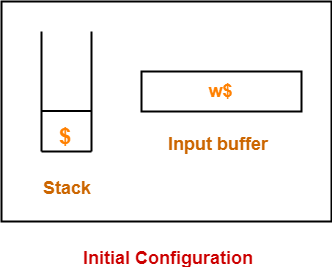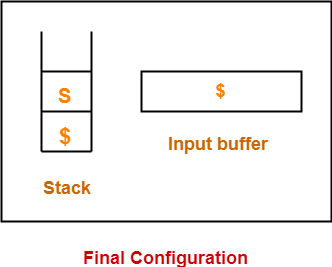Shift-Reduce Parser-
| A shift-reduce parser is a bottom-up parser. |
It takes the given input string and builds a parse tree-
- Starting from the bottom at the leaves.
- And growing the tree towards the top to the root.

Data Structures-
Two data structures are required to implement a shift-reduce parser-
- A Stack is required to hold the grammar symbols.
- An Input buffer is required to hold the string to be parsed.
Working-
Initially, shift-reduce parser is present in the following configuration where-
- Stack contains only the $ symbol.
- Input buffer contains the input string with $ at its end.

The parser works by-
- Moving the input symbols on the top of the stack.
- Until a handle β appears on the top of the stack.
The parser keeps on repeating this cycle until-
- An error is detected.
- Or stack is left with only the start symbol and the input buffer becomes empty.

After achieving this configuration,
- The parser stops / halts.
- It reports the successful completion of parsing.
Possible Actions-
A shift-reduce parser can possibly make the following four actions-
1. Shift-
In a shift action,
- The next symbol is shifted onto the top of the stack.
2. Reduce-
In a reduce action,
- The handle appearing on the stack top is replaced with the appropriate non-terminal symbol.
3. Accept-
In an accept action,
- The parser reports the successful completion of parsing.
4. Error-
In this state,
- The parser becomes confused and is not able to make any decision.
- It can neither perform shift action nor reduce action nor accept action.
Rules To Remember
It is important to remember the following rules while performing the shift-reduce action-
|
PRACTICE PROBLEMS BASED ON SHIFT-REDUCE PARSING-
Problem-01:
Consider the following grammar-
E → E – E
E → E x E
E → id
Parse the input string id – id x id using a shift-reduce parser.
Solution-
The priority order is: id > x > –
| Stack | Input Buffer | Parsing Action |
| $ | id – id x id $ | Shift |
| $ id | – id x id $ | Reduce E → id |
| $ E | – id x id $ | Shift |
| $ E – | id x id $ | Shift |
| $ E – id | x id $ | Reduce E → id |
| $ E – E | x id $ | Shift |
| $ E – E x | id $ | Shift |
| $ E – E x id | $ | Reduce E → id |
| $ E – E x E | $ | Reduce E → E x E |
| $ E – E | $ | Reduce E → E – E |
| $ E | $ | Accept |
Problem-02:
Consider the following grammar-
S → ( L ) | a
L → L , S | S
Parse the input string ( a , ( a , a ) ) using a shift-reduce parser.
Solution-
| Stack | Input Buffer | Parsing Action |
| $ | ( a , ( a , a ) ) $ | Shift |
| $ ( | a , ( a , a ) ) $ | Shift |
| $ ( a | , ( a , a ) ) $ | Reduce S → a |
| $ ( S | , ( a , a ) ) $ | Reduce L → S |
| $ ( L | , ( a , a ) ) $ | Shift |
| $ ( L , | ( a , a ) ) $ | Shift |
| $ ( L , ( | a , a ) ) $ | Shift |
| $ ( L , ( a | , a ) ) $ | Reduce S → a |
| $ ( L , ( S | , a ) ) $ | Reduce L → S |
| $ ( L , ( L | , a ) ) $ | Shift |
| $ ( L , ( L , | a ) ) $ | Shift |
| $ ( L , ( L , a | ) ) $ | Reduce S → a |
| $ ( L , ( L , S ) | ) ) $ | Reduce L → L , S |
| $ ( L , ( L | ) ) $ | Shift |
| $ ( L , ( L ) | ) $ | Reduce S → (L) |
| $ ( L , S | ) $ | Reduce L → L , S |
| $ ( L | ) $ | Shift |
| $ ( L ) | $ | Reduce S → (L) |
| $ S | $ | Accept |
Problem-03:
Consider the following grammar-
S → T L
T → int | float
L → L , id | id
Parse the input string int id , id ; using a shift-reduce parser.
Solution-
| Stack | Input Buffer | Parsing Action |
| $ | int id , id ; $ | Shift |
| $ int | id , id ; $ | Reduce T → int |
| $ T | id , id ; $ | Shift |
| $ T id | , id ; $ | Reduce L → id |
| $ T L | , id ; $ | Shift |
| $ T L , | id ; $ | Shift |
| $ T L , id | ; $ | Reduce L → L , id |
| $ T L | ; $ | Shift |
| $ T L ; | $ | Reduce S → T L |
| $ S | $ | Accept |
Problem-04:
Considering the string “10201”, design a shift-reduce parser for the following grammar-
S → 0S0 | 1S1 | 2
Solution-
| Stack | Input Buffer | Parsing Action |
| $ | 1 0 2 0 1 $ | Shift |
| $ 1 | 0 2 0 1 $ | Shift |
| $ 1 0 | 2 0 1 $ | Shift |
| $ 1 0 2 | 0 1 $ | Reduce S → 2 |
| $ 1 0 S | 0 1 $ | Shift |
| $ 1 0 S 0 | 1 $ | Reduce S → 0 S 0 |
| $ 1 S | 1 $ | Shift |
| $ 1 S 1 | $ | Reduce S → 1 S 1 |
| $ S | $ | Accept |
To gain better understanding about Shift-Reduce Parsing,
Download Handwritten Notes Here-
Next Article- Operator Precedence Parsing
Get more notes and other study material of Compiler Design.
Watch video lectures by visiting our YouTube channel LearnVidFun.
